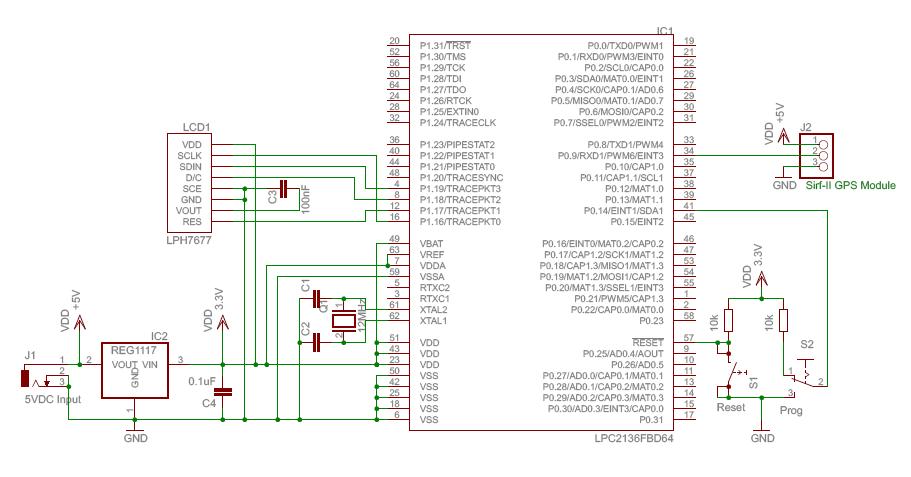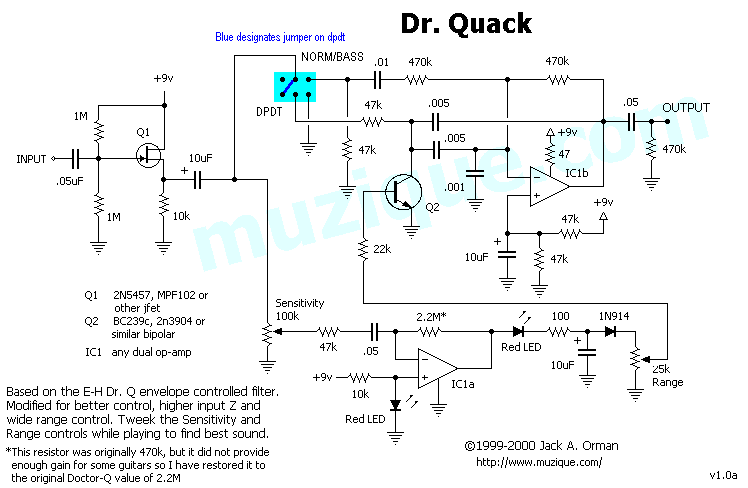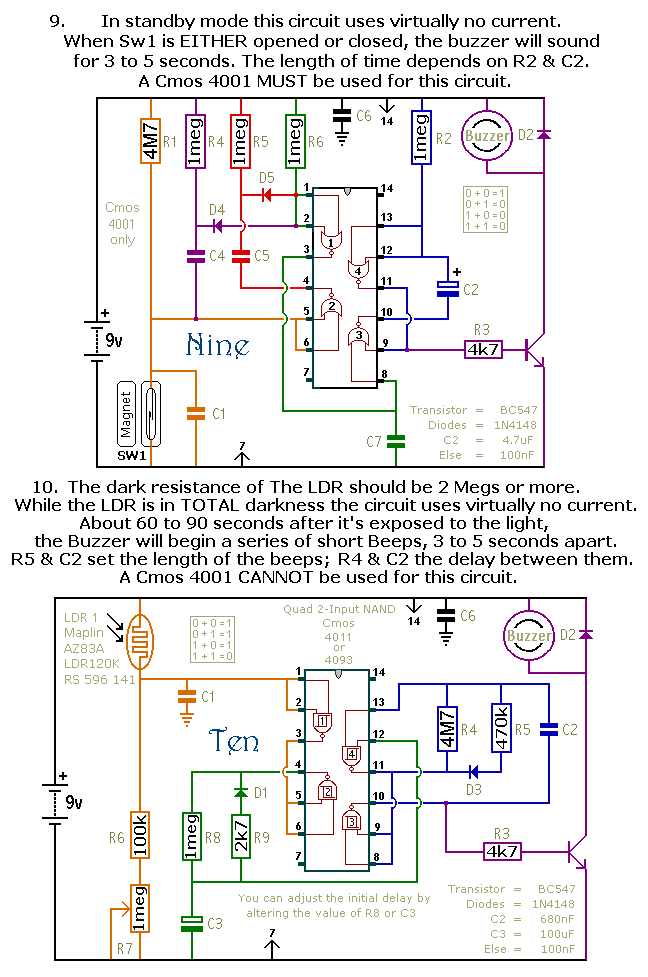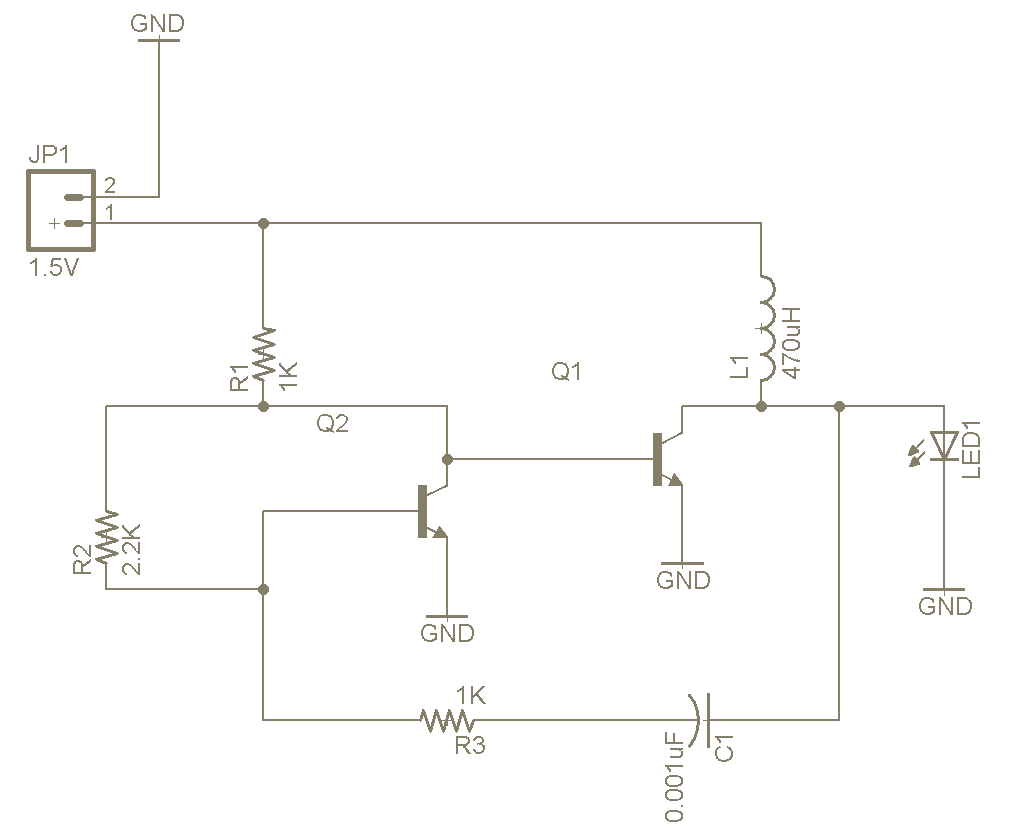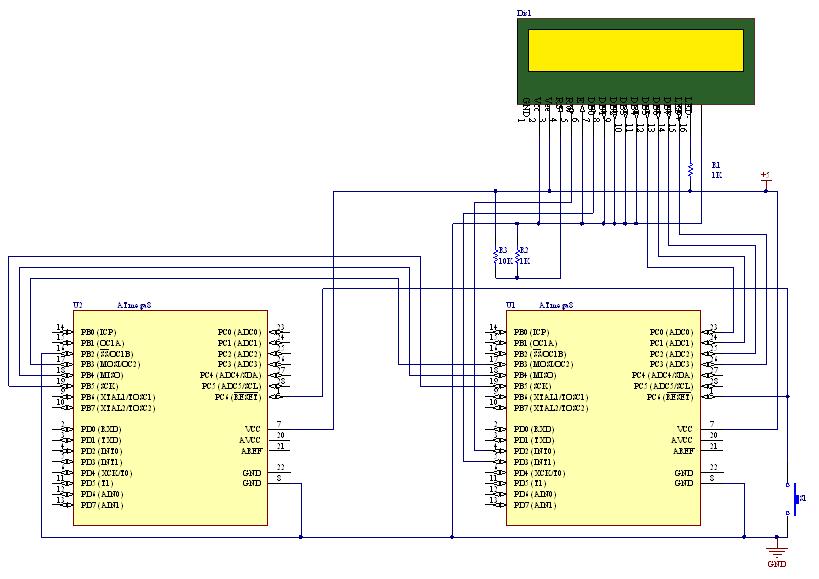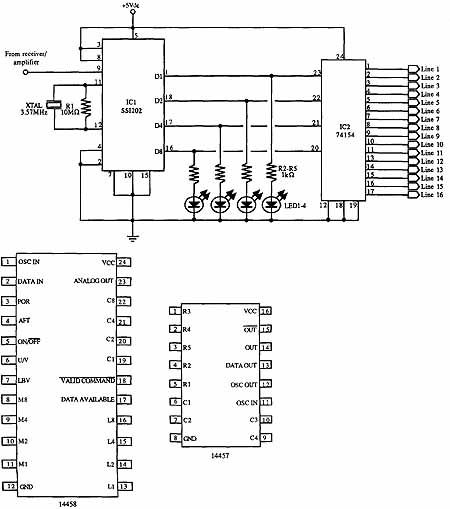
AVR Projects
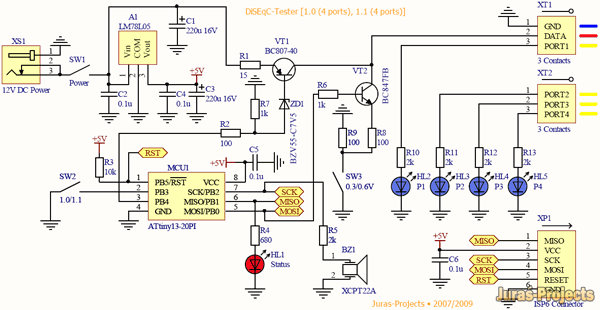
This project involves the DiSEqC-Tester, which is designed to test DiSEqC switches utilizing protocols 1.0 and 1.1. The device is compatible with DiSEqC switches that follow protocols 2.0 and 2.1, as they maintain backward compatibility with the earlier versions. The tester sends a DiSEqC message every second to operate the switch. Four LEDs indicate the on/off status of the switch's ports. To use the tester, connect the red wire to the "Receiver" input of the switch, the blue wire to the case, and the remaining yellow wires to the switch ports in any order. After selecting the protocol and tone level, power on the device. A functional DiSEqC switch will cause a blue LED on the tester to alternate with another blue LED, accompanied by a short red LED blink and a beep. The device generates a DiSEqC message with a duration of 54 ms, consisting of 4 bytes plus a 9th odd bit. If protocol 1.0 is selected, the device sends command sequences including $E01038C0, while protocol 1.1 uses sequences such as $E01039F0. These commands correspond to "Write Port Group N0" and "Write Port Group N1" in the DiSEqC protocol. For instance, the message $E01038C0 activates port "LNB1" on a DiSEqC switch. The DiSEqC-Tester_T2313_rev_A supports 4 ports for protocol 1.0 and 8 ports for protocol 1.1, with a large pause after every 4th or 8th command. The device can also generate the 22kHz tone if enabled by a DIP switch, which is used to select the protocol and mode. The tester includes improved short circuit protection and is capable of testing 22kHz switches. A button is available for manual mode operation, where a message is sent upon pressing the button. The DiSEqC-Converter is intended for PC DVB cards lacking support for DiSEqC 1.2, allowing for the decoding of DiSEqC 1.0 messages and sending DiSEqC 1.2 messages to a motor. The converter can generate any DiSEqC message, with eight messages stored in the EEPROM of the MCU. The message length can vary from three to six bytes, and the generator can provide a 22kHz tone, with pauses of 15 ms before and after the DiSEqC message. The number of required DiSEqC messages is selected by pins A0 to A2 of the MCU. Caution is advised when programming the MCU with an ISP programmer, particularly regarding the RESET pin, as improper settings can prevent future programming.
The DiSEqC-Tester is a versatile tool for testing and generating DiSEqC messages, crucial for the operation of satellite communication systems. The device's ability to handle multiple protocols and its compatibility with various DiSEqC switch types make it an essential component for engineers and technicians working in the field of satellite technology. The integration of LEDs for visual feedback enhances usability, allowing for immediate status indications during testing.
The circuitry of the DiSEqC-Tester includes a microcontroller (MCU) that manages the generation and transmission of DiSEqC messages. The MCU interfaces with a series of input and output pins, where the DIP switch configuration allows users to select between different operational modes and protocols. The inclusion of EEPROM provides storage for commonly used DiSEqC messages, enabling quick access and execution.
The design also incorporates protection features to safeguard against short circuits, ensuring the reliability of the tester during use. The option to enable a 22kHz tone adds functionality, allowing for compatibility with additional switch types that require this feature. The manual operation mode through a push button provides flexibility for users to test specific scenarios on demand.
Overall, the DiSEqC-Tester serves as a robust solution for testing and generating DiSEqC commands, facilitating the maintenance and setup of satellite reception systems. Its thoughtful design and comprehensive features make it a valuable asset for professionals in the electronics and telecommunications industry.This is my first AVR-project on this page. The DiSEqC-Tester allows to test DiSEqC-switches that uses 1. 0 or 1. 1 protocols. (DiSEqC-Switches with 2. 0 and 2. 1 protocol have backwards compatibility with 1. 0 & 1. 1 respectively and also may be tested). The device every second sends a DiSEqC-message that makes switch a DiSEqC-switch. Four LEDs are inte nded to show on/off state of ports of a DiSEqC-switch. To test a DiSEqC-switch you must connect the red wire with "Receiver" input of the switch, blue wire with case, connect remaining yellow wires to ports of the switch in any order. Choose the protocol, tone-level and then turn power on. If the DiSEqC-switch is OK, a blue LED of the tester will be switching every second to another blue LED with short red LED blinking and beeping.
Next photo and video shows how it looks. The device every second generates a DiSEqC-message which has duration of 54ms. Each message consist from 4 bytes. Byte is 8 bit + 9-th odd bit. If protocol 1. 0 is used, then device sends next commands-sequences: $E01038C0, $E01038C4, $E01038C8, $E01038CC, $E01038C0 and so later, else $E01039F0, $E01039F1, $E01039F2, $E01039F3, $E01039F0. These commands are so called "Write Port Group N0" (38h) and "Write Port Group N1" (39h) by DiSEqC-Protocol.
The full description of DiSEqC-Protocol can be found at Eutelsat web site. For example, DiSEqC-Message $E01038C0 switches port "LNB1" of DiSEqC-Switch 1. 0/2. 0 into active state. DiSEqC-Tester_T2313_rev_A - DiSEqC 1. 0 (4 ports), 1. 1 (8 porst), 1. 2 ("west", "east"). After every 4-th/8-th command - large pause (for protocols 1. 0 and 1. 1). No large pauses in 1. 2-protocol mode. The archive contains some diagrams. Number of port-LEDs may be variable, for example 8 or 10, and depends on type of your DiSEqC-Switch. In fact, this device is a DiSEqC-generator, that generates standard DiSEqC-messages. This version of tester is able to provide the 22kHz between the messages, if enabled by DIP-Switch. The DIP-Switch is intended to select protocol and mode you need. Also the DiSEqC-Tester v2 has an improved short circuit protection. Additionally, the 22kHz tone support allows you to test an 22kHz-switch. The DIP-switch allows to select DiSEqC level, type of framing byte and few other capabilities (see schematic diagram). The button is used only in manual mode, when the tester sends a message after button pressing. The DiSEqC-Converter is intended for PC DVB-cards which have not support the DiSEqC 1. 2 level. Also some cards can work poorly with DiSEqC 1. 2. The device decodes DiSEqC 1. 0 messages and sends DiSEqC 1. 2 messages to a motor. A position corresponds to a port of DiSEqC 1. 0. Four positions are possible, because it is the restriction of the DiSEqC 1. 0 level. The converter sends a message to a motor when DiSEqC 1. 0 port number is changing to another. The device can generate any DiSEqC-message. Eight DiSEqC-messages are stored in EEPROM of MCU. The length of a message can be three to six bytes. Also the generator is able to provide 22kHz tone. When 22kHz tone is used (A3=1), you can see at the diagram the pauses of 15ms before and after DiSEqC-message.
The pauses are also present when 22kHz tone is disabled (A3=0). For example: 0x04, 0xE0, 0x10, 0x38, 0xCC, 0x00, 0x00, 0x00 - DiSEqC 1. 0 message, length of the message is 4 bytes, will switch port #4 of a DiSEqC-Switch 1. 0/2. 0. The number of required DiSEqC-message is selected by pins A0. A2 of MCU. If you are using an ISP-programmer, when it is necessary to use RESET-pin during the programming, after you set RSTDSBL FUSE to zero, you`ll cannot program your MCU more, only it will be possible with a High-Voltage programmator. To prevent such situations, use the simplified solution of the DiSEqC-Generator. This version does not use RESET-pin as general in-out pin. 🔗 External reference
The DiSEqC-Tester is a versatile tool for testing and generating DiSEqC messages, crucial for the operation of satellite communication systems. The device's ability to handle multiple protocols and its compatibility with various DiSEqC switch types make it an essential component for engineers and technicians working in the field of satellite technology. The integration of LEDs for visual feedback enhances usability, allowing for immediate status indications during testing.
The circuitry of the DiSEqC-Tester includes a microcontroller (MCU) that manages the generation and transmission of DiSEqC messages. The MCU interfaces with a series of input and output pins, where the DIP switch configuration allows users to select between different operational modes and protocols. The inclusion of EEPROM provides storage for commonly used DiSEqC messages, enabling quick access and execution.
The design also incorporates protection features to safeguard against short circuits, ensuring the reliability of the tester during use. The option to enable a 22kHz tone adds functionality, allowing for compatibility with additional switch types that require this feature. The manual operation mode through a push button provides flexibility for users to test specific scenarios on demand.
Overall, the DiSEqC-Tester serves as a robust solution for testing and generating DiSEqC commands, facilitating the maintenance and setup of satellite reception systems. Its thoughtful design and comprehensive features make it a valuable asset for professionals in the electronics and telecommunications industry.This is my first AVR-project on this page. The DiSEqC-Tester allows to test DiSEqC-switches that uses 1. 0 or 1. 1 protocols. (DiSEqC-Switches with 2. 0 and 2. 1 protocol have backwards compatibility with 1. 0 & 1. 1 respectively and also may be tested). The device every second sends a DiSEqC-message that makes switch a DiSEqC-switch. Four LEDs are inte nded to show on/off state of ports of a DiSEqC-switch. To test a DiSEqC-switch you must connect the red wire with "Receiver" input of the switch, blue wire with case, connect remaining yellow wires to ports of the switch in any order. Choose the protocol, tone-level and then turn power on. If the DiSEqC-switch is OK, a blue LED of the tester will be switching every second to another blue LED with short red LED blinking and beeping.
Next photo and video shows how it looks. The device every second generates a DiSEqC-message which has duration of 54ms. Each message consist from 4 bytes. Byte is 8 bit + 9-th odd bit. If protocol 1. 0 is used, then device sends next commands-sequences: $E01038C0, $E01038C4, $E01038C8, $E01038CC, $E01038C0 and so later, else $E01039F0, $E01039F1, $E01039F2, $E01039F3, $E01039F0. These commands are so called "Write Port Group N0" (38h) and "Write Port Group N1" (39h) by DiSEqC-Protocol.
The full description of DiSEqC-Protocol can be found at Eutelsat web site. For example, DiSEqC-Message $E01038C0 switches port "LNB1" of DiSEqC-Switch 1. 0/2. 0 into active state. DiSEqC-Tester_T2313_rev_A - DiSEqC 1. 0 (4 ports), 1. 1 (8 porst), 1. 2 ("west", "east"). After every 4-th/8-th command - large pause (for protocols 1. 0 and 1. 1). No large pauses in 1. 2-protocol mode. The archive contains some diagrams. Number of port-LEDs may be variable, for example 8 or 10, and depends on type of your DiSEqC-Switch. In fact, this device is a DiSEqC-generator, that generates standard DiSEqC-messages. This version of tester is able to provide the 22kHz between the messages, if enabled by DIP-Switch. The DIP-Switch is intended to select protocol and mode you need. Also the DiSEqC-Tester v2 has an improved short circuit protection. Additionally, the 22kHz tone support allows you to test an 22kHz-switch. The DIP-switch allows to select DiSEqC level, type of framing byte and few other capabilities (see schematic diagram). The button is used only in manual mode, when the tester sends a message after button pressing. The DiSEqC-Converter is intended for PC DVB-cards which have not support the DiSEqC 1. 2 level. Also some cards can work poorly with DiSEqC 1. 2. The device decodes DiSEqC 1. 0 messages and sends DiSEqC 1. 2 messages to a motor. A position corresponds to a port of DiSEqC 1. 0. Four positions are possible, because it is the restriction of the DiSEqC 1. 0 level. The converter sends a message to a motor when DiSEqC 1. 0 port number is changing to another. The device can generate any DiSEqC-message. Eight DiSEqC-messages are stored in EEPROM of MCU. The length of a message can be three to six bytes. Also the generator is able to provide 22kHz tone. When 22kHz tone is used (A3=1), you can see at the diagram the pauses of 15ms before and after DiSEqC-message.
The pauses are also present when 22kHz tone is disabled (A3=0). For example: 0x04, 0xE0, 0x10, 0x38, 0xCC, 0x00, 0x00, 0x00 - DiSEqC 1. 0 message, length of the message is 4 bytes, will switch port #4 of a DiSEqC-Switch 1. 0/2. 0. The number of required DiSEqC-message is selected by pins A0. A2 of MCU. If you are using an ISP-programmer, when it is necessary to use RESET-pin during the programming, after you set RSTDSBL FUSE to zero, you`ll cannot program your MCU more, only it will be possible with a High-Voltage programmator. To prevent such situations, use the simplified solution of the DiSEqC-Generator. This version does not use RESET-pin as general in-out pin. 🔗 External reference
